

Classic Buses Profiles
"UNBUSTABLE" - London to New Zealand in the 1970s (by Dick Gilbert)
A story of very long-distance bus travel, produced in co-operation with Bernard Cleary.
Last updated 27 November 2020
SOME LINKS WITHIN THIS WEBSITE: Home Email Links THE COMPLETE WEBSITE MENU Events Diary Halfcab list Small-Ads Classic Irish Buses Classic Manx Buses
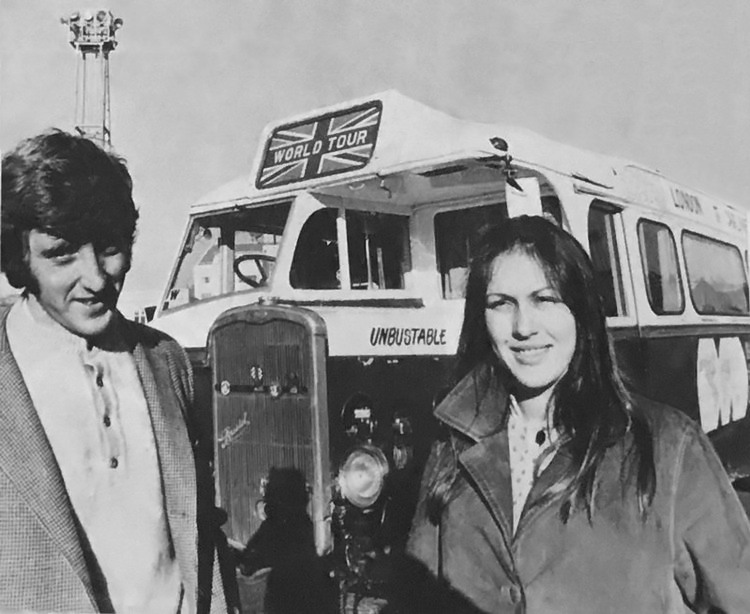
Bernard Cleary and his wife Loredana with the former United Auto JO5G bus (Unbustable) on their arrival in Wellington, New Zealand from Sydney in 1972.
This tale begins in March 1936 when a Bristol JO5G single decker bus registered BHN 237 was delivered to United Automobile Services in Darlington as part of a batch of 60 acquired by them that year. The fleet numbers (BJO6 to BJO65) were allotted in order of body number - i.e. the order that the buses emerged from the Eastern Counties coachbuilding factory in Lowestoft (rather than the more common chassis number order) so BHN 237 became BJO42.
According to Gerry Tormey, that guru of all things Bristol, BHN 237 operated on United Auto routes around the north east through the war but was rebuilt at the end of 1946 by Woodall Nicholson of Halifax, who have been making coach bodies for nearly 200 years, dating back to the days of horse-drawn carriages and hansom cabs. In May 1951 the bus changed its fleet number to BJ41 but was retired from service soon afterwards. By 1955 it had been acquired by the Northern Electricity Board in Newcastle upon Tyne and was converted to a mobile display vehicle. Already over 30 years old, its next move was to be bought by a showman in 1967 who adapted it for living accommodation; and then along came Bernard.
In 1969 Bernard Cleary was a 23 year old mechanic living in Whetstone, near Finchley in north London. He was fascinated by buses and came up with the plan of driving one around the world. Having shared the idea with his friend, bus enthusiast and draughtsman Roy Jackson, he was most interested to hear that Roy had spotted BHN 237 in Spain while on a working holiday and thought it might be for sale. Bernard went to look at it, liked it and paid £100 for it. Although Bernard and Roy had both qualified at their various trades, they both spent some time as London Transport bus drivers working out of Muswell Hill garage which had Routemaster, RT and RF buses which they found great fun to drive. They were never going to get rich but it was an enjoyable job.
The bus was driven back from Spain to England and 1970 and nearly £500 was spent overhauling it on a farm near Potters Bar. With the help of friends the engine was stripped down and showed surprisingly little signs of wear, despite not having been reconditioned since 1952. The seats were taken out to make room for bunks, cupboards, a table, a cooker and the kitchen sink.
Meanwhile preparations were made for the journey. Despite being refused access to Burma and parts of Russia, a route to Australia was mapped out, although details were a bit vague after leaving Europe. Along with Bernard and his fiancee, Roy was to be co-driver, and two other friends were coming too. Finally the bus was ready for departure from Finchley on 1 November 1970 and a sceptical bunch of well-wishers turned up to see them off for their round the world expedition.
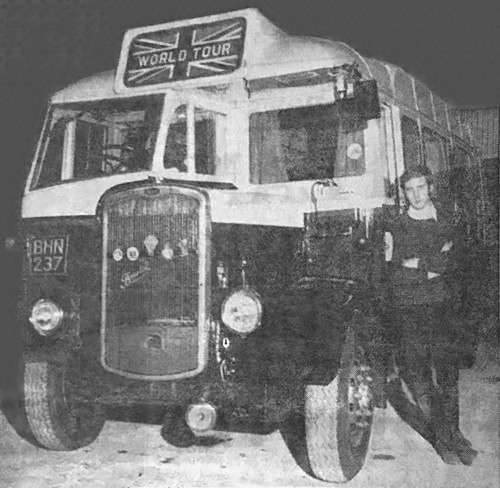
The journey commenced through France and Italy, where Bernard married Loredana in her Italian home town. Roy Jackson was the best man. So then there was another send-off celebration as they departed to Yugoslavia and Bulgaria. It started to get more challenging in Turkey and Iran. Bernard warned that those who imagine these countries are lands of burning deserts shouldn't travel through them in winter! From Sivas in central Turkey to Herat in Afghanistan they encountered snow and ice all the way. Despite spectacular scenery in eastern Turkey, driving through passes as high as 10,000 feet, the temperatures were low enough to freeze diesel. Worried that the engine might not start, the team kept it running round the clock for five days.
The weather got better as they pressed on into Afghanistan and driving was easier. The combined efforts of the USA and Russia led to a good road being laid across what was otherwise a pretty wild country. They found the Afghans a happy and friendly people who were very surprised to find only five people travelling in a big bus - they were more used to buses being completely overloaded with passengers, animals and freight, inside, outside and on the roof!
Leaving Afghanistan through the Khyber Pass was an incredible way to enter the Indian subcontinent and was to remain in the memories of the travellers for the rest of their lives. Indians were fascinated by the bus and crowded round to offer assistance at every opportunity. No other vehicle in India seemed to be running on radial tyres, perhaps because they thought that the soft, flexible sidewalls would not stand up to the rigours of Asian roads. But BHN 237 was proving them wrong.
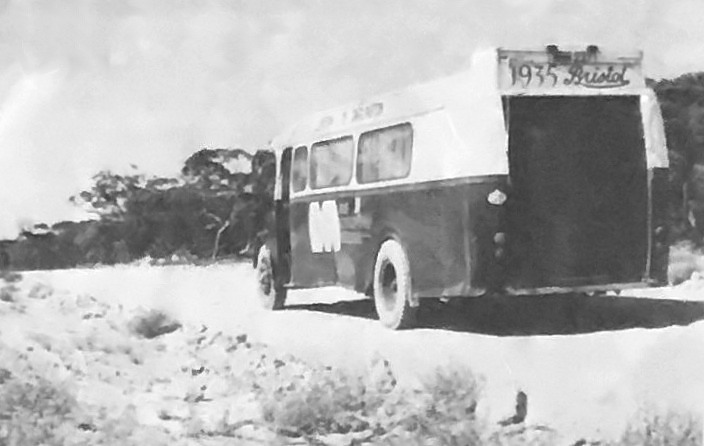
While in northern India the team decided to take a diversion into the tiny kingdom of Nepal and visited the capital Katmandhu in a valley in the lower Himalayas. The city is 120 miles from the Indian border by a tortuous road, about three times the distance of the same journey by air. From Katmandhu they took the opportunity to head further north to view the old frontier into Tibet. Then it was time to head south again into India and they spent some time in the capital city, Delhi.
The team made friends with Ranjan Marwah, a journalist on the Hindustan Times. As well as writing an article for the newspaper about their progress, it was Ranjan who came up with the name unBUStable. He reported that the suspension was a bit unforgiving and the roof leaked a bit, but otherwise the occupants had a deep affection and respect for the bus. They did earn a little money and help in India, some from Coca Cola and Nescafe and also from an American lady who wanted them to help find her child (which, says Bernard, is another story...) Then it was on via Bombay to Madras where the bus was loaded onto a Russian cargo ship heading for Singapore - the Russian ship being 10% cheaper than all the others.
Although the money earned in India helped towards the shipping costs, money was getting a bit tight by the time the gang arrived in Singapore, so they left the bus behind and set off for Australia without it. But in March 1972 BHN 237 arrived in Perth, Western Australia, and the journey began again. They found Australia a very different experience from overcrowded Asia, and the ghost towns, wild outback and the empty Nullarbor Plain came as a bit of a shock. The relentless heat also gave them quite a thirst for Australian beer!
Then it was on to Adelaide, Melbourne and up to the coast at Brisbane. While in Australia Bernard wrote an article for Michelin magazine, in which he praised their radial tyres which had still not suffered a single puncture. Michelin paid him for the article and offered to supply new tyres at cost, but it wasn't necessary. Finally the party travelled down to Sydney where the bus sailed across to Wellington, New Zealand. It arrived there in 1972 after clocking up 30,000 miles through 22 countries in 21 months. Extraordinarily the 45 year old bus had suffered no serious mechanical problems.
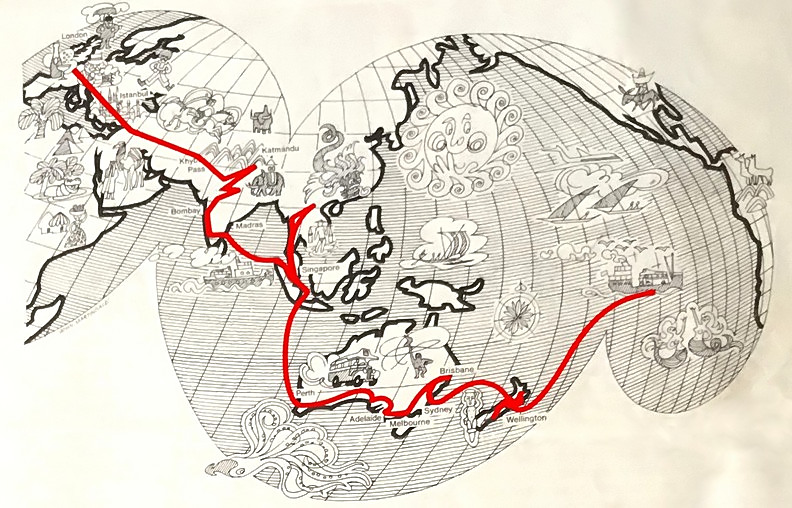
Although the team had intended to press on towards South America and the United States, that never actually took place. Instead they went back to Australia and drove up to Darwin shortly after cyclone Tracy in 1975. The bus was sold in 1976 in Darwin to a couple from Queensland, and that looked like the end of the story - but it wasn't. In 2006 I heard from Clay Atkinson in Queensland who had acquired the remains of BHN 237 which he said he hoped to restore.
In April 2006 Clay said "Looks like things are starting to come together to finally bring the Bristol home, I have a friend who believes he can borrow a truck and trailer for a weekend so we will go and pick it up ourselves. As you can see from the photo, the driver's cab looks quite unstable so I will be removing the windscreen and building some bracing in the cab area to support the roof during the trip. I will keep you posted on the progress."
In October 2006 Clay sent more info; "I thought I would let you know that I have finally got the Bristol back home to Brisbane. It was an interesting exercise, we organised with a local farmer at the pickup point to give us a hand, with his tractor to load it. He was very concerned initially that his machine would not be powerful enough to do the job, but once we got it rolling, steering and stopping, he soon got into the spirit of the occasion. All in all it only took an hour and a half to come up with a plan and get it on the truck, luckily there was a loading ramp that we were able to use which was great."
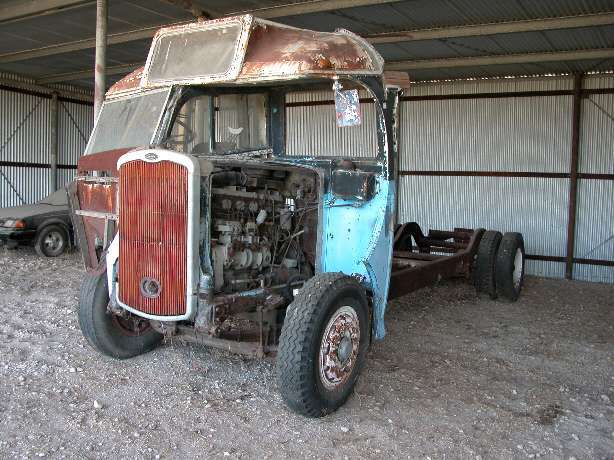
"Getting it off at home was another thing, we had no loading ramp and very little flat ground so we ran the truck up a reasonably steep embankment and lowered it off using a pair of 7 foot ramps, a snatch block and the winch on my Nissan Patrol. It was a slow and challenging task and took about 5 hours. Now for the hard bit, getting started on the restoration! Keep you posted." Thanks Clay, and good luck with the restoration.
And then, in February 2018 I received this from Bernard Cleary in the UK: "Please can you tell me if any progress has been made on the restoration of BHN 237? My interest is that I was the person who brought the bus to Australia in 1971. I could be travelling to Australia in the coming year and would be interested to see what has happened to it." So I sent a request to Clay for updated information, but my email address for him was 12 years out of date and didn't work. Subsequently I've tracked him down to Brendale, Queensland and I'm continuing to try to make contact. If anyone can help, please let me know! Meanwhile I will post all news and progress on this page as it happens.
Many thanks to Bernard for the information and to Michelin magazine for use of some of their material.
In November 2020 Peter Berry sent me the following; "They were still in New Zealand for Easter 1973 and they attended the first ever vintage bus rally to be held in New Zealand at Taupo in the middle of the North Island. Buses in attendance were, from MOTAT Auckland a 1955 ex North Shore Transport Seddon halfcab, from Wellington ex WCT AEC Regal III no. 23 and an ex WCT Leyland OPS1, and our 1950 Dennis Lancet 3 ex Northern Bus Company, Whangarei. We chose Taupo for its central location. Our Dennis is now in a derelict condition in storage with the Omnibus Society, Wellington." Thanks very much Peter.
====================================
For more great travellers' tales, see these links:
Travelling 1: Dave's wonderful photo collection of buses that eventually became travellers' homes.
Travelling 2: India Overland with Asian Greyhound and Swagman Tours in the 1970s. A great website!
Travelling 3: Memories of a Top Deck Travel driver / tour manager from 1976 to 2010.
Travelling 4: A Flickr group about Sundekkers and Suntrecker, and their overland adventure buses.
Travelling 5: "Just the Ticket", young people travelling around Europe in a London RTL in the 1960s.
Travelling 6: Highroad for Oz, a 48-day service from London to Calcutta in an Albion double decker (1968-1976).
Travelling 7: My own overland trip to Iran in 1970, four pages.
Travelling 8: Fancy re-living the old Hippie Trail in a modern luxury bus? You can, with Adventures Overland's bus to London!
Travelling 9: "By wheelchair to Greece", a great tale of a 1966 journey to Athens and back (with wheelchairs!) in ex London Transport Leyland Tiger TD89 (pdf download).
SOME LINKS WITHIN THIS WEBSITE: Home Email Links THE COMPLETE WEBSITE MENU Events Diary Halfcab list Small-Ads Classic Irish Buses Classic Manx Buses